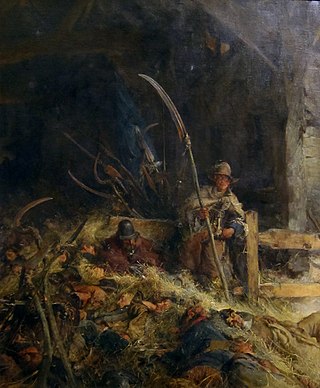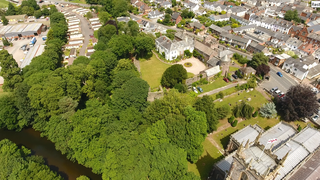Related Research Articles

James Scott, 1st Duke of Monmouth, 1st Duke of Buccleuch, was a Dutch-born English nobleman and military officer. Originally called James Crofts or James Fitzroy, he was born in Rotterdam in the Netherlands, the eldest illegitimate son of Charles II of England with his mistress Lucy Walter.

The Battle of Sedgemoor was the last and decisive engagement between the Kingdom of England and rebels led by the Duke of Monmouth during the Monmouth rebellion, fought on 6 July 1685, and took place at Westonzoyland near Bridgwater in Somerset, England, resulting in a victory for the English army.

The Monmouth Rebellion, also known as the Pitchfork Rebellion, the Revolt of the West or the West Country rebellion, was an attempt to depose James II, who in February 1685 succeeded his brother Charles II as king of England, Scotland and Ireland. A group of dissident Protestants led by James Scott, 1st Duke of Monmouth, eldest illegitimate son of Charles II, opposed James largely due to his Catholicism.

Thomas Herbert, 8th Earl of Pembroke and 5th Earl of Montgomery,, styled The Honourable Thomas Herbert until 1683, was an English and later British statesman during the reigns of William III and Anne.

Westonzoyland is a village and civil parish in Somerset, England. It is situated on the Somerset Levels, 4 miles (6.4 km) south east of Bridgwater.
Events from the year 1685 in England. This year sees a change of monarch.
Henry Bertie, JP, of Chesterton, Oxfordshire was an English soldier and Tory politician who sat in the English and British House of Commons between 1678 and 1715.
The Royal Wiltshire Militia was an auxiliary regiment of the British Army from the English county of Wiltshire. From their formal organisation as Trained Bands in 1558 until their final service in the Special Reserve, the Militia regiments of the county carried out internal security and garrison duties at home and overseas in all of Britain's major wars. The Wiltshire Militia was active in suppressing Monmouth's Rebellion in 1685 and was present at the Battle of Sedgemoor. It became a battalion of the Wiltshire Regiment in 1881 and trained thousands of reservists and recruits during World War I. It maintained a shadowy existence until final disbandment in 1953.

Sir William Sharington was an English landowner and merchant, a courtier of the time of Henry VIII, master and embezzler of the Bristol Mint, member of parliament, conspirator, and High Sheriff of Wiltshire.

Sir John Talbot was an English politician, soldier, and landowner, who was Member of Parliament for various seats between 1660 and 1685. He held rank in a number of regiments, although he does not appear to have seen active service.

William Strode III was a wealthy English landowner, Member of Parliament, and aider of the Duke of Monmouth in the Monmouth Rebellion (1685).
Thomas Mompesson (1630–1701), of Mompesson House, The Close, Salisbury and St Martin's Lane, Westminster, was an English politician. He entered Lincoln's Inn in 1648, and was called to the bar in 1654.

Sir Gilbert Talbot was an English diplomat, who held offices in the Republic of Venice from 1634 to 1645, then Denmark-Norway from 1664 to 1666. He was Member of Parliament for Plymouth, from 1666 to 1679.
The Dorset Militia was an auxiliary military force in the county of Dorsetshire in South West England. From their formal organisation as Trained Bands in 1558 until their final service as the Special Reserve, the Militia regiments of the county carried out internal security and home defence duties. They saw active service during the Second Bishops' War and the English Civil War, and played a prominent part in suppressing the Monmouth Rebellion. After being the first English militia regiment to reform in 1758, they served in home defence in all of Britain's major wars, including service in Ireland, and finally trained thousands of reinforcements during World War I. After a shadowy postwar existence they were formally disbanded in 1953.

The Siege of Tiverton took place in October 1645 during the First English Civil War, when a Royalist garrison surrendered to a detachment of the New Model Army.
The Devon Militia was a part-time military force in the maritime county of Devonshire in the West of England. From their formal organisation as Trained Bands in 1558 until their final service as a Special Reserve unit of the Devonshire Regiment in World War I, the Militia regiments of Devonshire served in home defence in all of Britain's major wars.
The Gloucestershire Militia was a part-time military force in the county of Gloucestershire in the West of England. From their formal organisation as Trained Bands in 1558 until their final service as a Special Reserve unit of the Gloucestershire Regiment in World War I, the Militia regiments of the county served in home defence in all of Britain's major wars.
The Somerset Militia was an auxiliary military force in the county of Somerset in South West England. From their formal organisation as Trained Bands in 1558 until their final service as the Special Reserve, the Militia regiments of the county carried out internal security and home defence duties in all of Britain's major wars. They saw active service during the Second Bishops' War, the English Civil War, the Monmouth Rebellion and the Second Boer War, and finally trained thousands of reinforcements during World War I. After a shadowy postwar existence they were formally disbanded in 1953.

The Battle of Norton St Philip was fought on June 27, 1685, during the Monmouth Rebellion in the village of Norton St Philip, in Somerset, England. The battle was the last victory for the rebel forces.
The Battle of Bridport was fought on June 14, 1685, at the start of the Monmouth Rebellion in the town of Bridport, in Dorset, England. The battle was a victory for the Royalist forces and the rebels were forced to march to Axminster.
References
- David Chandler, Sedgemoor 1685: An Account and an Anthology, London: Anthony Mott, 1985, ISN 0-907746-43-8.
- Christopher L. Scott, The military effectiveness of the West Country Militia at the time of the Monmouth Rebellion, Cranfield University PhD thesis 2011.